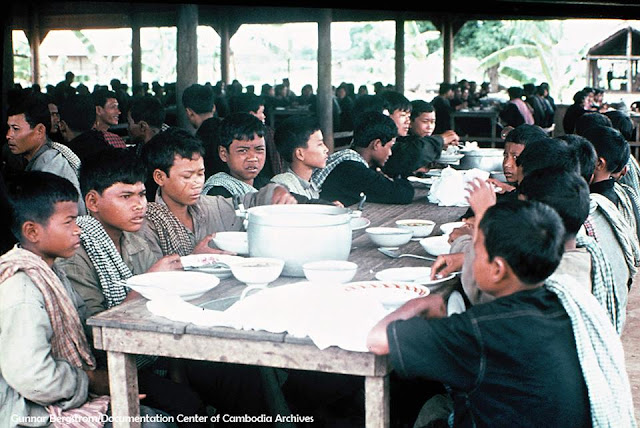រេាងបាយសហករណ៍សម័យខ្មែរក្រហម-Khmer Rouge Communal Eating Hall.
ឆ្នាំ១៩៧៧ ខ្មែរក្រហមបានបង្កើតឲ្យមានការហូបរួមក្នុងសហករណ៍ទូទាំងប្រទេសកម្ពុជា ហើយបានហាមការដាំដុះដំណាំកសិផលក្បែរផ្ទះ ដែលប្រជាជនកម្ពុជា តែងតែដាំសម្រាប់ផ្គត់ផ្គង់នៅក្នុងគ្រួសារ អស់រយៈពេលជាច្រើនសតវត្សរ៍កន្លងមកហើយ។ ទីកន្លែងតែមួយគត់ដែលប្រជាជនកម្ពុជាអាចទទួលទានអាហារបាន គឺមានតែនៅរោងបាយសហករណ៍តែមួយប៉ុណ្ណោះ។ ប្រជាជនទាំងអស់ត្រូវពឹងផ្អែកទាំងស្រុងទៅលើរបបអាហារដែលខ្មែរក្រហមផ្តល់ឲ្យដើម្បីចិញ្ចឹមជីវិត។ ក៏ប៉ុន្តែរបបអាហារដែលទទួលបានទាំងនោះ មានចំនួនតិចជាងចំនួនដែលមនុស្សម្នាក់ៗត្រូវការទៅទៀត ជាពិសេស សម្រាប់អ្នកដែលត្រូវបង្ខំ ឲ្យធ្វើការងារធ្ងន់ធ្ងរជាប់រហូតច្រើនម៉ោង។
កុមារ និងអ្នកភូមិកំពុងហូបបាយនៅក្នុងរោងបាយរួមគ្នា ក្នុងខែសីហា ឆ្នាំ១៩៧៨ ក្នុង អំឡុងពេលដំណើរទស្សនកិច្ចរបស់ ហ្គូណា ប៊ើហ្គស្រ្តូម និងគណៈប្រតិភូកុម្មុយនិស្តស៊ុយអែតមកកាន់កម្ពុជាប្រជាធិបតេយ្យ។ កុមារនិងអ្នកភូមិទាំងនេះ ស្លៀកពាក់និងរៀបចំយ៉ាងស្អាតបាត។ ពីរបីទសវត្សរ៍ ក្រោយមកទើប ហ្គូណា ប៊ើហ្គស្រ្តូម ដឹងថា នេះគ្រាន់តែជាឈុតឆាកបង្កើតឡើងដើម្បីផ្គាប់ចិត្តគណៈប្រតិភូតែប៉ុណ្ណោះ។
Khmer Rouge Communal Eating Hall
In 1977, Khmer Rouge established the communal eating in cooperatives across Cambodia. Khmer Rouge forbade planting any crops near residential houses, which Cambodian people had done to afford their living for centuries. The only place where Cambodian people could have meal was just only the cooperative eating hall. All the people completely depended on the food ration the Khmer Rouge provided to live. However, the provided food ration was less than what the individual required, in particularly, one who was forced to perform hard labor for many hours.
Children and villagers eating in the communal hall in August, 1978 during the visit of Gunnar Bergstrom and his Swedish delegation to Democratic Kampuchea. Children and villagers were dressed up and well prepared. It was decades later that Gunnar Bergstrom realized that the scene was set up to impress the delegation.
Photos: Gunnar Bergstrom/Documentation Center of Cambodia Archives












No comments:
Post a Comment